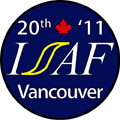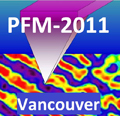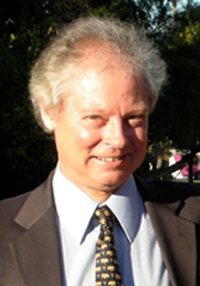Stephen J. Pennycook |
Dr. Stephen J. Pennycook is a Corporate Fellow in the Materials Science and Technology Division at Oak Ridge National Laboratory and leader of the Scanning Transmission Electron Microscopy Group. He also holds the position of Professor in the Dept. of Physics and Astronomy, Vanderbilt University and the Dept. of Materials Science and Engineering, University of Tennessee. He received his PhD in physics from the Cavendish Laboratory, University of Cambridge in 1978, moving to Oak Ridge in 1982. For the development and application of Z-contrast scanning transmission electron microscopy he received a Research and Development R&D 100 Award in 1990, the Microbeam Analysis Society Heinrich Award in 1992, the Materials Research Society Medal in 1992 and the Institute of Physics Thomas J. Young Medal and Award in 2001. Pennycook is a Fellow of the American Physical Society, the American Association for the Advancement of Science, the Microscopy Society of America and the Institute of Physics. His research interests focus on the development of Z‑contrast scanning transmission electron microscopy and electron energy loss spectroscopy with sub-Angstrom resolution, and applications to materials science, catalysis and nanoscience. He has over 350 publications in refereed journals and has given over 180 invited presentations on the development and application of atomic resolution Z-contrast microscopy and electron energy loss spectroscopy. |
|
Oak Ridge National Lab., USA |
||
Probing Ferroelectric Functionality Cell-by-Cell by Aberration-Corrected STEM
The recent introduction of next-generation aberration correctors has propelled the capabilities of the scanning transmission electron microscope (STEM) to a whole new level of sensitivity. The resolution has increased to well below 1 Å, allowing atomic column positions to be extracted with unprecedented precision, and making possible the mapping of ferroelectric displacements on a unit cell by unit cell basis. Furthermore, the STEM allows multiple, simultaneous images to be acquired, Z-contrast images, dominated by the heavy cation columns can be obtained with either bright field images (sensitive to oxygen column positions) or electron energy loss signals (allowing mapping of elemental composition, electronic structure and dielectric properties. Correlating these signals at atomic resolution across interfaces enables new insights into screening mechanisms and the role of lattice constraints, such as suppression of octahedral rotations.
As a case study several examples will be shown of BiFeO3, mapping polarization direct from a Z-contrast image [1], mapping octahedral rotations across interfaces with electrodes, the observation of an induced dielectric anomaly, the influence of vacancy ordering on polarization and the use of column shape analysis to locate and identify domain walls [2]. Experimental results will be complemented by model theoretical studies [3].
[1] A. Y. Borisevich et al., Phys. Rev. Lett. 105, 087204 (2010).
[2] A. Y. Borisevich et al., ACS Nano, 4, 6071 (2010).
[3] J. He at al., Phys. Rev. Lett., 105, 227203 (2010).
Research sponsored by the Materials Sciences and Engineering Division, Office of Basic Energy Sciences, U.S. Department of Energy (SJP, MV, AYB, JL, HJC, DNL), DE-FG02-09ER46554 (STP, MPO), by the Shared Research Equipment (SHaRE) User Facility, Oak Ridge National Laboratory, sponsored by the Scientific User Facilities Division, Office of Basic Energy Sciences, U.S. Department of Energy (AYB) and by the McMinn Endowment (STP) at Vanderbilt University. Computations were supported by the National Energy Research Scientific Computing Center.







